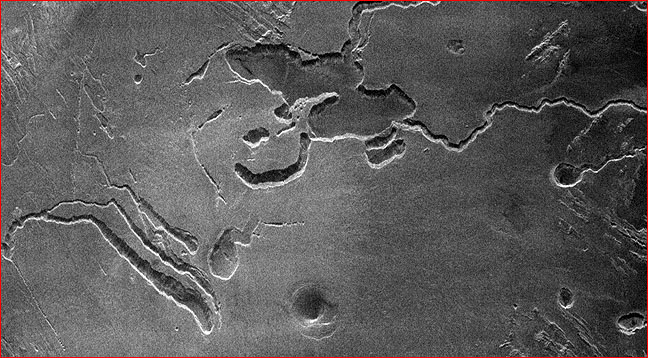
home •
about •
essential guide •
picture of the day •
thunderblogs •
news •
multimedia •
predictions •
products •
get involved •
contact
picture of the day archive subject index
Perhaps this radar image of the planet Venus’ surface can tell us more about the supposed methane rivers
and lakes of Saturn’s moon Titan than all of the speculations of NASA scientists.
Aug 15, 2006
Titan Update—Our Prediction StandsRecent weeks have seen growing confidence by NASA scientists that they have observed methane “lakes” on Saturn’s moon Titan. But we stand by our prediction that no methane lakes will be found.
On July 27, Nature magazine published a study by R. Hueso and A Sanchez-Lavega, suggesting that surface features on Titan include dry river channels cut by periodic downpours of methane and regional floods. This study, combined with earlier stories concerning supposed “lakes” of methane at Titan’s north pole, has provoked many optimistic headlines in scientific journals.
“At Last, Methane Lakes on Saturn’s Icy Moon Titan,” reads a headline in Science magazine. According to Science News, the radar images give the “first
compelling evidence for bodies of liquid on the surface of any object besides Earth.” And the New Scientist speaks of rivers on Titan “that are probably liquid ethane or methane.”
In the issue of Nature discussing “methane storms” on Titan, the journal also published another study under the direction of lead author Tetsuya Tokano, from the University of Cologne, Germany. According to this study, based on the Huygens probe dropped to the surface of Titan, “the data indicate an upper methane ice cloud and a lower, barely visible, liquid methane-nitrogen cloud, with a gap in between.” The report concludes that, by wetting Titan’s surface globally, the drizzle “plays an active role in the surface geology of Titan.”
The scientific reports have set up an ideal opportunity to test the predictive ability of two models. In our Picture of the Day for December 28, 2004, following the lead of Wallace Thornhill, we suggested that Titan’s surface features should be compared to those of Venus. In Thornhill’s interpretation, Titan’s recent birth is the reason for its dense but diminishing methane atmosphere. In this hypothesis a similarity of Titan’s surface to that of Venus would be expected. We noted:
“In the first close-up image of Titan’s surface by Cassini a “Venusian-type” dome was tentatively identified. We can also expect many flat-bottomed valleys bordered by steep cliffs with scalloped edges—a common signature of high-energy surface machining by electricity. And while planetary scientists puzzle over the absence of craters, we predict that, as higher resolution images of the surface are returned, many regions will reveal channels formed of overlapping smaller craters and parallel grooves that can be expected of discharge streamers raking across the surface.”
When NASA scientists looked at radar images showing channels appearing to “feed” into flat bottomed depressions, they thought they were seeing methane lakes fed by episodic methane rivers. But for obvious reasons NASA scientists have not noticed the similarity between radar images of Venus’ surface and those of Titan’s surface. They have no reason to associate these two bodies so remote from each other. In the radar image of Venus above, we see both flat-bottomed depressions and river-like channels, presenting a parallel to Titan’s “lakes” too obvious to miss. In fact our prediction of “flat-bottomed valleys bordered by steep cliffs with scalloped edges” turns out to be a perfect description of what we actually observe in the radar images of Titan. So we are not deterred by the confidence of NASA scientists: When Cassini takes a closer look at the north polar region in question, they will not find what they are looking for, except by straining credulity further.
And really, how credible is the claim of methane rivers feeding methane lakes on Titan? Thornhill contends that while a dense methane fog can “dampen” the ground, it cannot generate the torrential rains that various NASA scientists have depicted in response to the Titan radar images. It will not create rivers and lakes. According to Christopher McKay, a scientist at NASA Ames Research Center in California's Silicon Valley and second author of the Tokano study noted above, "The rain on Titan is just a slight drizzle, but it rains all the time, day in, day out. It makes the ground wet and muddy with liquid methane. This is why the Huygens probe landed with a splat. It landed in methane mud," said.
"We determined that the rain on Titan is equal to about two inches (about 5 centimeters) a year," McKay said. "This is about as much rain as Death Valley (receives). The difference is (that) on Titan, this rain is spread out evenly over the entire year."
Could two inches of methane precipitation, spread out over a year, contribute significantly to the carving of surface relief? Would it cut “riverbeds” on Titan that some have compared to the action of flash floods, creating large lakes of standing methane? In fact, the marginal precipitation from a fog, expected by Thornhill, appears to be exactly what the Huygens probe detected.
Despite the headlines and self-congratulations there is every reason for skepticism about NASA’s claims. Given Thornhill's solo success in predicting the nature of Titan's surface before the Huygens Probe saw beneath its thick clouds, we are confident that no methane rivers or lakes of any size will be found on Titan. Both the channels and the flat-floored depressions were cut by electrical discharge in the tumultuous early history of the moon.
___________________________________________________________________________Please visit our Forum
The Electric Sky and The Electric Universe available now!

|
|

|
EXECUTIVE EDITORS:
David Talbott, Wallace Thornhill
MANAGING EDITORS:
Steve Smith, Mel Acheson
CONTRIBUTING EDITORS: Dwardu Cardona, Ev Cochrane,
C.J. Ransom, Don Scott, Rens van der Sluijs, Ian Tresman
WEBMASTER: Brian Talbott
Copyright 2006: thunderbolts.info
![]()
home •
thunderblogs •
forum •
picture of the day •
resources •
team •
updates •
contact us

